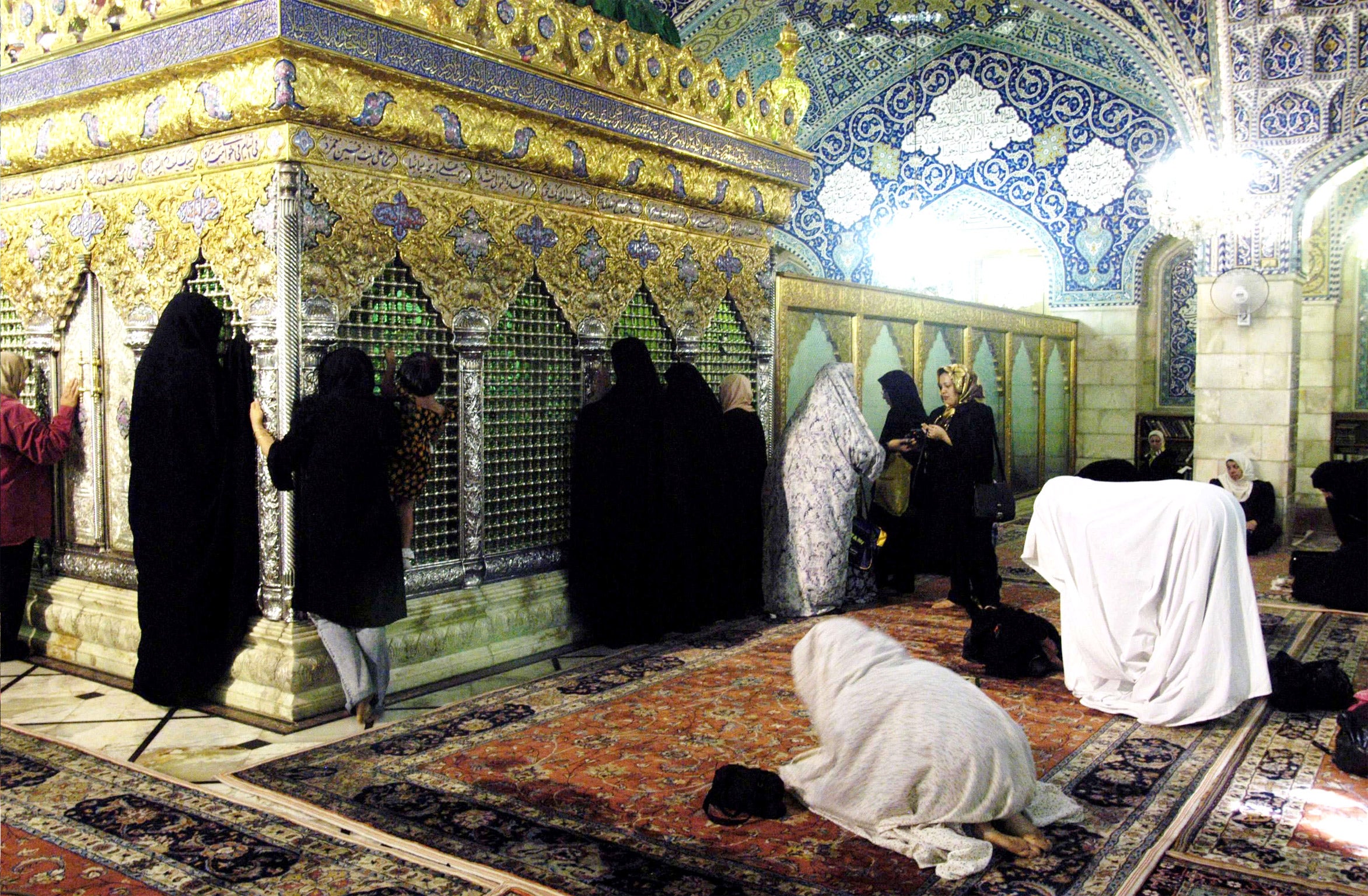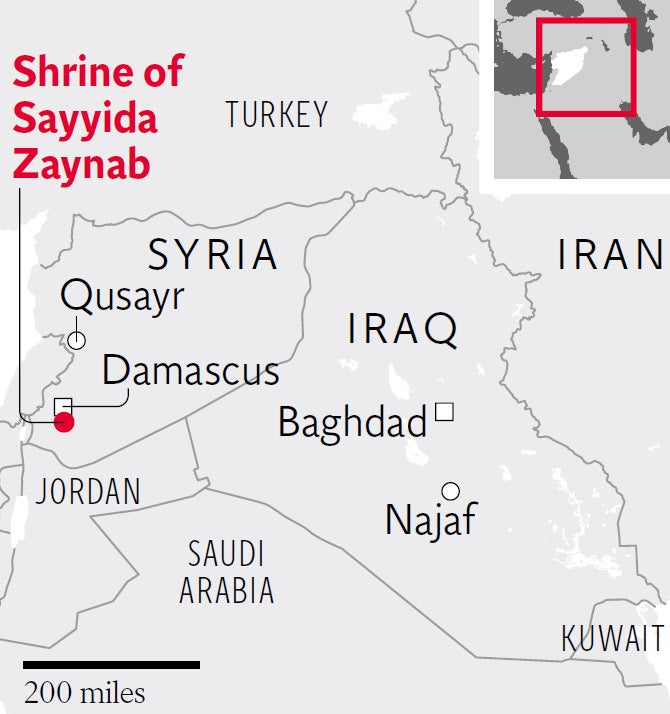The road from Iraq to Damascus: Iraqis fight to the death to defend Shia shrines - they show less zeal for Assad's regime
Thousands of Iraqi Shia's are in Syria, as much from economic need as ideological conviction, as the country turns into the principal battleground of sectarian conflict in the Muslim world

Your support helps us to tell the story
From reproductive rights to climate change to Big Tech, The Independent is on the ground when the story is developing. Whether it's investigating the financials of Elon Musk's pro-Trump PAC or producing our latest documentary, 'The A Word', which shines a light on the American women fighting for reproductive rights, we know how important it is to parse out the facts from the messaging.
At such a critical moment in US history, we need reporters on the ground. Your donation allows us to keep sending journalists to speak to both sides of the story.
The Independent is trusted by Americans across the entire political spectrum. And unlike many other quality news outlets, we choose not to lock Americans out of our reporting and analysis with paywalls. We believe quality journalism should be available to everyone, paid for by those who can afford it.
Your support makes all the difference.In Damascus, Shia men from Iraq fight to the death to defend the Shia shrine of Sayyida Zaynab, the daughter of Ali and Fatimah and the grand-daughter of the Prophet Mohamed. They battle with less enthusiasm, however, for the Baathist government of President Bashar al-Assad, which reminds them of the regime of Saddam Hussein.
Sattar Khalaf, an Iraqi wounded in Damascus, says: “Fighting in Syria is to defend the shrines of the Prophet’s family and not the regime of Bashar al-Assad and the Baath Party.”
This is not always a distinction easily made. Shia leaders say that at any one time there are between 3,800 and 4,700 Iraqi fighters in Syria, but new volunteers have not been registered for the last five months. The 20 million Shia Mulims in Iraq feel threatened by the Sunni-dominated opposition in Syria’s bid to overthrow the regime there, and its repercussions in Iraq. The Islamic State of Iraq and the Levant (Isil), the al-Qa’ida umbrella organisation which has been fighting against Syrian regime forces, draws no distinction between its attacks on the Syrian army and non-Sunni Syrians. In Iraq, Shia and Kurdish civilians are its main target.
But the Shia political and religious leadership in Iraq is reluctant to be drawn into the war next door despite Iranian promptings. Grand Ayatollah Ali al-Sistani and the Shia religious establishment have refused to issue a fatwa calling for Iraqi Shia to go to fight in Syria, though they have not condemned those who do volunteer. In contrast to the Iranian religious authorities in Qom, the message from their Iraqi counterparts in Najaf is more emphatic that Muslims should not fight Muslims.
Iraqi fighters cross into Syria by land, though the road via the Sunni Anbar province is so dangerous that they fly instead by plane to Damascus from Baghdad or Najaf. Flights have been easier since the Syrian army cleared the area around the international airport. Sattar Khalaf, a 43-year-old from Baghdad who was part of 200-strong detachment travelling on five buses, says, “When we got into Syrian territory we were escorted by Syrian troops along the long road that was under the control of the army.”
He joined a group whose overall leader was an Iranian colonel. “The day I entered the shrine of Sayyida Zaynab I joined a group of a dozen fighters and our job was to plant bombs on road sides surrounding the area where the shrine is.” Other fighters with him were told to make hit-and-run attacks using rocket-propelled grenade launchers or to take part in street fighting.
He says, “In April I was hit in my shoulder while fighting near the airport and was taken back to Baghdad. Once I recover from my wound I will continue jihad in defending the shrine of Sayyida Zaynab.” He reckons between 12 and 20 Iraqi volunteers are being killed in Syria every month.
The Iraqi volunteers fighting in Syria are not as significant militarily as the experienced and battle-hardened Hezbollah units from Lebanon. They have played an important role as assault troops in capturing the strategic town of Qusayr near Homs, and in aiding the Syrian army in its advance into rebel-held parts of south Damascus.
Overall, foreign volunteers are less numerous among the pro-Assad forces than they are among the rebels. But the Iraqis’ presence underlines the degree to which Syria has become the main battle ground in the conflict between Shia and Sunni that is raging across the Muslim world. Last week, a jihadist group in Derna in Libya released a video of the shooting of an Iraqi Shia professor, Khalaf Hassan al-Sa’idi, shot in revenge for Sunni insurgents being executed by the Shia-led government in Baghdad.

Iran has been keen to encourage Iraqi Shia to fight in Syria and many of those who have done so come from Iranian-influenced groups such as Asa’ib Ahl al-Haq with between 2,000 and 3,000 fighters in Iraq in addition to some 800 combat-experienced troops from Hezbollah in Iraq (different from the Lebanese group of the same name). The motives of the men who volunteer for service are a mixture of ideology and poverty. “Ordinary fighters were offered a $700 (£427) a month salary, ex-fighters were paid according to their rank,” says Sattar Khalaf. “The non-commissioned officers with battle experience were offered $850 monthly and former officers’ salaries depended on their rank, starting from $1,500 per month.”
These are tempting sums in a society like Iraq where so many are jobless. Ghafil Khayoun Khadim is a 38-year-old unemployed construction worker with a wife and two children who lives in a tough Shia neighbourhood in east Baghdad. His story is worth recounting at length because it explains why so many men with little desire to fight anybody join militias not only in Iraq but in Syria, Lebanon and Libya.
Ghafil says he had no work in July and “I found myself penniless, my kids hungry and my wife in need of money, so I came around to the idea of fighting in Syria.” Another motive was that he is self-consciously Shia and “it is my duty to defend the shrine of the Sayyida Zaynab.” He received $500 up front and some military training.
Ghafil says he learned early on that there were two types of fighter: the ideologues who belonged to political parties and were well-trained, and the less political recruits who are taught “to disassemble and reassemble weapons.”
His group was flown to Damascus airport from where he was driven to the Sayyida Zaynab district. Next morning they were split up into units of 12, with his units consisting of seven Iraqis, two Iranians, a Lebanese leader, a Syrian captain and a civilian Syrian fighter.
What happened next was unexpected. Ghafil, who seems a little naive, said Iraqi militiamen at the shrine were praying for six martyrs killed in the fighting who had not died near the shrine itself. He says, “I showed astonishment, saying our mission is to defend Sayyida Zaynab shrine, not the Syrian regime and its army, but nobody listened to me.” A Syrian army vehicle took Ghafil’s unit to a position an hour’s drive away to the airport road where they took up positions: “They told us that the enemy might attack us at any time and we should shoot at anybody.”
Ghafil refused to fire his gun, saying he would only fight for the shrine and, if this did not happen, then he demanded to be taken back to Iraq, which was what ultimately happened. He says his friends and relatives in Baghdad are unsympathetic and believe he should have stayed and fought.
But he is adamant he did the right thing saying, “The reason I came back to my country is that I volunteered to fight in defence of Sayyida Zaynab shrine and not in defence of the Baathist regime in Syria.”
Join our commenting forum
Join thought-provoking conversations, follow other Independent readers and see their replies
Comments